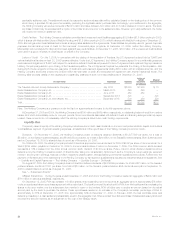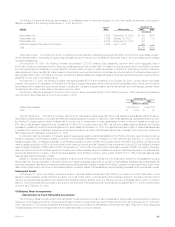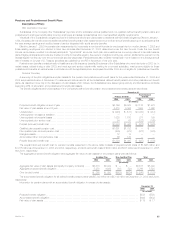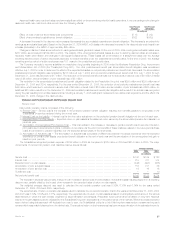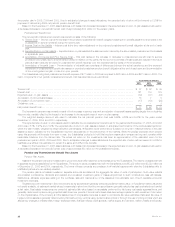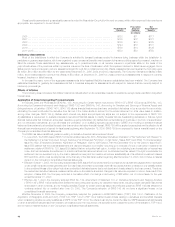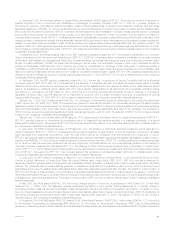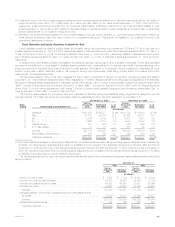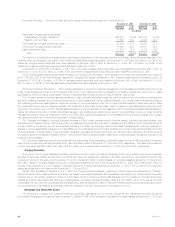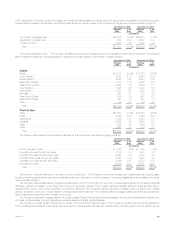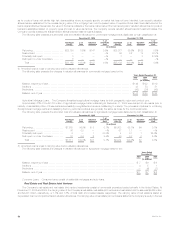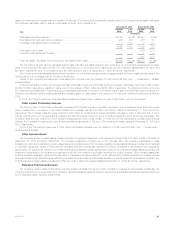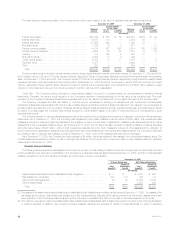MetLife 2005 Annual Report Download - page 45
Download and view the complete annual report
Please find page 45 of the 2005 MetLife annual report below. You can navigate through the pages in the report by either clicking on the pages listed below, or by using the keyword search tool below to find specific information within the annual report.the cost of all share-based transactions be measured at fair value and recognized over the period during which an employee is required to provide
service in exchange for an award. The SEC issued a final ruling in April 2005 allowing a public company that is not a small business issuer to implement
SFAS 123(r) at the beginning of the next fiscal year after June 15, 2005. Thus, the revised pronouncement must be adopted by the Company by
January 1, 2006. As permitted under SFAS 148, Accounting for Stock-Based Compensation — Transition and Disclosure — an amendment of FASB
Statement No. 123, the Company elected to use the prospective method of accounting for stock options granted subsequent to December 31, 2002.
Options granted prior to January 1, 2003 will continue to be accounted for under the intrinsic value method until the adoption of SFAS 123(r). In addition,
the pro forma impact of accounting for these options at fair value continued to be accounted for under the intrinsic value method until the last of those
options vested in 2005. As all stock options currently accounted for under the intrinsic value method vested prior to the effective date, implementation of
SFAS 123(r) will not have a significant impact on the Company’s consolidated financial statements.
In December 2004, the FASB issued FSP 109-2, Accounting and Disclosure Guidance for the Foreign Earnings Repatriation Provision within the
American Jobs Creation Act of 2004 (‘‘FSP 109-2’’). The American Jobs Creation Act of 2004 (‘‘AJCA’’) introduced a one-time dividend received
deduction on the repatriation of certain earnings to a U.S. taxpayer. FSP 109-2 provides companies additional time beyond the financial reporting period
of enactment to evaluate the effects of the AJCA on their plans to repatriate foreign earnings for purposes of applying SFAS No. 109, Accounting for
Income Taxes. During 2005, the Company recorded a $27 million income tax benefit related to the repatriation of foreign earnings pursuant to Internal
Revenue Code Section 965 for which a U.S. deferred income tax provision had previously been recorded.
Effective July 1, 2004, the Company prospectively adopted FSP No. 106-2, Accounting and Disclosure Requirements Related to the Medicare
Prescription Drug, Improvement and Modernization Act of 2003 (‘‘FSP 106-2’’). FSP 106-2 provides accounting guidance to employers that sponsor
postretirement health care plans that provide prescription drug benefits. The Company expects to receive subsidies on prescription drug benefits
beginning in 2006 under the Medicare Prescription Drug, Improvement and Modernization Act of 2003 based on the Company’s determination that the
prescription drug benefits offered under certain postretirement plans are actuarially equivalent to the benefits offered under Medicare Part D. The
postretirement benefit plan assets and accumulated benefit obligation were remeasured to determine the effect of the expected subsidies on net periodic
postretirement benefit cost. As a result, the accumulated postretirement benefit obligation was reduced by $213 million at July 1, 2004.
Effective July 1, 2004, the Company adopted EITF Issue No. 03-16, Accounting for Investments in Limited Liability Companies (‘‘EITF 03-16’’).
EITF 03-16 provides guidance regarding whether a limited liability company should be viewed as similar to a corporation or similar to a partnership for
purposes of determining whether a noncontrolling investment should be accounted for using the cost method or the equity method of accounting.
EITF 03-16 did not have a material impact on the Company’s consolidated financial statements.
Effective April 1, 2004, the Company adopted EITF Issue No. 03-6, Participating Securities and the Two — Class Method under FASB Statement
No. 128 (‘‘EITF 03-6’’). EITF 03-6 provides guidance on determining whether a security should be considered a participating security for purposes of
computing earnings per common share and how earnings should be allocated to the participating security. EITF 03-6 did not have an impact on the
Company’s earnings per common share calculations or amounts.
Effective January 1, 2004, the Company adopted SOP 03-1, as interpreted by a Technical Practice Aid (‘‘TPA’’), issued by the AICPA. SOP 03-1
provides guidance on (i) the classification and valuation of long-duration contract liabilities; (ii) the accounting for sales inducements; and (iii) separate
account presentation and valuation. In June 2004, the FASB released FSP No. 97-1, Situations in Which Paragraphs 17(b) and 20 of FASB Statement
No. 97, Accounting and Reporting by Insurance Enterprises for Certain Long-Duration Contracts and for Realized Gains and Losses from the Sale of
Investments, Permit or Require Accrual of an Unearned Revenue Liability (‘‘FSP 97-1’’), which included clarification that unearned revenue liabilities should
be considered in determining the necessary insurance benefit liability required under SOP 03-1. Since the Company had considered unearned revenue
in determining its SOP 03-1 benefit liabilities, FSP 97-1 did not impact its consolidated financial statements. As a result of the adoption of SOP 03-1,
effective January 1, 2004, the Company decreased the liability for future policyholder benefits for changes in the methodology relating to various
guaranteed death and annuitization benefits and for determining liabilities for certain universal life insurance contracts by $4 million, which has been
reported as a cumulative effect of a change in accounting. This amount is net of corresponding changes in DAC, including VOBA and unearned revenue
liability (‘‘offsets’’), under certain variable annuity and life contracts and income taxes. Certain other contracts sold by the Company provide for a return
through periodic crediting rates, surrender adjustments or termination adjustments based on the total return of a contractually referenced pool of assets
owned by the Company. To the extent that such contracts are not accounted for as derivatives under the provisions of SFAS No. 133 and not already
credited to the contract account balance, under SOP 03-1 the change relating to the fair value of the referenced pool of assets is recorded as a liability
with the change in the liability recorded as policyholder benefits and claims. Prior to the adoption of SOP 03-1, the Company recorded the change in
such liability as other comprehensive income. At adoption, this change decreased net income and increased other comprehensive income by
$63 million, net of income taxes, which were recorded as cumulative effects of changes in accounting. Effective with the adoption of SOP 03-1, costs
associated with enhanced or bonus crediting rates to contractholders must be deferred and amortized over the life of the related contract using
assumptions consistent with the amortization of DAC. Since the Company followed a similar approach prior to adoption of SOP 03-1, the provisions of
SOP 03-1 relating to sales inducements had no significant impact on the Company’s consolidated financial statements. In accordance with SOP 03-1’s
guidance for the reporting of certain separate accounts, at adoption, the Company also reclassified $1.7 billion of separate account assets to general
account investments and $1.7 billion of separate account liabilities to future policy benefits and policyholder account balances. This reclassification
decreased net income and increased other comprehensive income by $27 million, net of income taxes, which were reported as cumulative effects of
changes in accounting. Due to the adoption of SOP 03-1, the Company recorded a cumulative effect of a change in accounting of $86 million, net of
income taxes of $46 million, for the year ended December 31, 2004.
In December 2003, FASB revised SFAS No. 132, Employers’ Disclosures about Pensions and Other Postretirement Benefits — an Amendment of
FASB Statements No. 87, 88 and 106 (‘‘SFAS 132(r)’’). SFAS 132(r) retains most of the disclosure requirements of SFAS 132 and requires additional
disclosure about assets, obligations, cash flows and net periodic benefit cost of defined benefit pension plans and other postretirement plans.
SFAS 132(r) was primarily effective for fiscal years ending after December 15, 2003; however, certain disclosures about foreign plans and estimated
future benefit payments were effective for fiscal years ending after June 15, 2004. The Company’s adoption of SFAS 132(r) did not have a significant
impact on its consolidated financial statements since it only revised disclosure requirements.
During 2003, the Company adopted FASB Interpretation (‘‘FIN’’) No. 46, Consolidation of Variable Interest Entities — An Interpretation of Accounting
Research Bulletin (‘‘ARB’’) No. 51 (‘‘FIN 46’’), and its December 2003 revision (‘‘FIN 46(r)’’). Certain of the Company’s investments in real estate joint
ventures and other limited partnership interests meet the definition of a variable interest entity (‘‘VIE’’) and have been consolidated, in accordance with the
transition rules and effective dates, because the Company is deemed to be the primary beneficiary. A VIE is defined as (i) any entity in which the equity
investments at risk in such entity do not have the characteristics of a controlling financial interest; or (ii) any entity that does not have sufficient equity at risk
MetLife, Inc.
42


